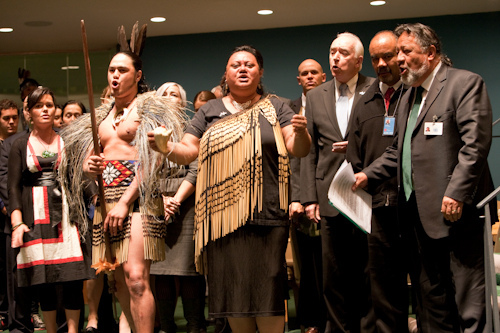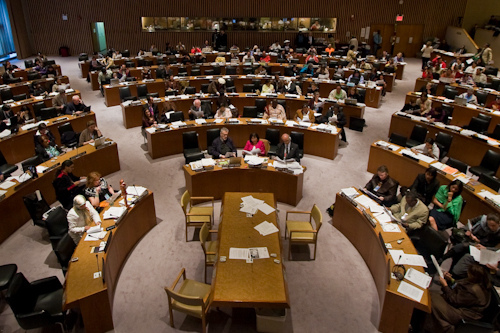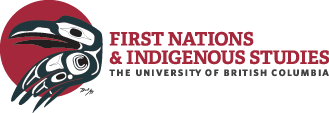What is the UNDRIP?

From the Ninth Session of the Permanent Forum on Indigenous Issues. New Zealand delegation celebrates the endorsement by the Government of New Zealand of the United Nations Declaration on the Rights of Indigenous Peoples. Photo: Broddi Sigurdarson. (c) 2010 UNPFII. Used with permission from UNPFII.
The United Nations Declaration on the Rights of Indigenous Peoples (UNDRIP) is an international instrument adopted by the United Nations on September 13, 2007, to enshrine (according to Article 43) the rights that “constitute the minimum standards for the survival, dignity and well-being of the indigenous peoples of the world.” The UNDRIP protects collective rights that may not be addressed in other human rights charters that emphasize individual rights, and it also safeguards the individual rights of Indigenous people. The Declaration is the product of almost 25 years of deliberation by U.N. member states and Indigenous groups.
The first of the UNDRIP’s 46 articles declares that “Indigenous peoples have the right to the full enjoyment, as a collective or as individuals, of all human rights and fundamental freedoms as recognized in the Charter of the United Nations, the Universal Declaration of Human Rights(4) and international human rights law.” The Declaration goes on to guarantee the rights of Indigenous peoples to enjoy and practice their cultures and customs, their religions, and their languages, and to develop and strengthen their economies and their social and political institutions. Indigenous peoples have the right to be free from discrimination, and the right to a nationality.
Read the UN Declaration on the Rights of Indigenous Peoples here.
Significantly, in Article 3 the UNDRIP recognizes Indigenous peoples’ right to self-determination, which includes the right “to freely determine their political status and freely pursue their economic, social and cultural development.” Article 4 affirms Indigenous peoples’ right “to autonomy or self-government in matters relating to their internal and local affairs,” and Article 5 protects their right “to maintain and strengthen their distinct political, legal, economic, social and cultural institutions.” Article 26 states that “Indigenous peoples have the right to the lands, territories and resources which they have traditionally owned, occupied or otherwise used or acquired,” and it directs states to give legal recognition to these territories. The Declaration does not override the rights of Indigenous peoples contained in their treaties and agreements with individual states, and it commands these states to observe and enforce the agreements.
The UNDRIP was adopted by 144 countries, with 11 abstentions and 4 countries voting against it. These four countries were Canada, the USA, New Zealand, and Australia. Since 2009 Australia and New Zealand have reversed their positions and now support the Declaration, while the United States and Canada have announced that they will revise their positions.
Read the UNDRIP here.
Drafting the UNDRIP
In 1982, UN Special Rapporteur of the Subcommission on the Prevention of Discrimination and Protection of Minorities, José R. Martinez Cobo, released a study about the systemic discrimination faced by Indigenous peoples worldwide. His findings were released as the “Study of the Problem of Discrimination against Indigenous Populations” and can be read online. The UN Economic and Social Council (UNECOSOC) responded to these findings by creating the Working Group on Indigenous Populations (WGIP), comprised of five independent experts as well as Indigenous advisors, in order to focus exclusively on Indigenous issues worldwide. Its role was to make recommendations to the Commission of Human Rights through the Subcommission.1
In consultation with Indigenous representatives from around the world, the WGIP began to draft a declaration of Indigenous Rights in 1985. The initial draft was developed over eight years, and was submitted in 1993 to the Subcommission on the Prevention of Discrimination and Protection of Minorities (now known as the Subcommission on the Promotion and Protection of Human Rights), who approved it the following year. Upon its approval, the draft declaration was sent to the Commission of Human Rights, which established another working group consisting of human rights experts and over 100 Indigenous organizations.2 The draft declaration was subject to a series of reviews to assure U.N. member states that it remained consistent with established human rights, and did not contradict nor override them.

The Seventh Session of the Permanent Forum on Indigenous Issues. (c) 2008 UNPFII. Photo used with permission from UNPFII.
The UNDRIP deals with a wide spectrum of Indigenous rights, a consideration much debated during initial discussions. There was much tension between U.N. member states and Indigenous peoples’ representatives during the drafting, due to presumed competing interests. Many U.N. member states worried that accepting the UNDRIP as drafted would undermine their own political autonomy. Of particular concern were the articles affirming Indigenous peoples’ right to self-determination. However, many Indigenous representatives refused to change the draft, arguing that the document simply extended to Indigenous peoples the rights already guaranteed to colonialists.3 The authors of the UN Declaration sought to break free of this colonial mindset, not reinforce it. As human rights lawyer James Sa’ke’j Youngblood Henderson observes, “[Member states] worried about the implications of Indigenous rights, refusing to acknowledge the privileges they had appropriated for themselves.”4
The Working Group’s final draft represented a compromise between UN member states and Indigenous representatives (see, for example, Article 46, which, among other things, protects the political unity of an existing state). In 2006, the draft was accepted by the UN Human Rights Council, and the following year, it was adopted by a majority of the UN. General Assembly.
The non-signatories: Australia, Canada, New Zealand, and the United States
Australia, New Zealand, Canada, and the United States initially refused to sign the UNDRIP. The four countries share very similar colonial histories and, as a result, have common concerns. Each nation argued that the level of autonomy recognized for Indigenous peoples in the UNDRIP was problematic and would undermine the sovereignty of their own states, particularly in the context of land disputes and natural resource extraction. Some governments claimed that the UNDRIP might override existing human rights obligations, even though the document itself explicitly gives precedence to international human rights (see Article 46). The UNDRIP may, however, provide guiding principles that national courts could use to judge a government’s actions in cases involving Indigenous rights.
Canada, the United States, Australia and New Zealand have all pointed to their track records in upholding human rights, including the recognition of Indigenous rights within their own national governance systems, as a justification for their reluctance to endorse the UNDRIP. They have noted that many nations that have signed on to the UNDRIP do not appear to uphold these minimum standards. While many agree that much work remains to be done internationally, critics have questioned the four nations’ claims to their fulfillment of international standards. Ojibwe political scientist Sheryl Lightfoot, for example, observes that such compliance is often concentrated in “soft rights,” such as rights to language and culture, while systematically denying “hard rights,” such as rights to land.5
Over 2009 and 2010, Australia, New Zealand, Canada and the United States reversed their positions, and now support the UNDRIP. Some critics believe that despite their change in position, each nation’s commitment remains lukewarm at best. Lightfoot points to the frequency of terms like “aspirational” and “non-binding” in these governments’ official announcements, and cautions that by using these terms the governments in question seek to exempt themselves from any legal responsibility to the UNDRIP. 6 In Australia’s April 2009 official statement, for example, Member of Parliament Jenny Macklin called the Declaration “historic and aspirational.” And one year later, New Zealand’s Minister of Maori Affairs, Dr. Pita Sharples, described her government’s change of heart this way:
New Zealand
Read New Zealand’s official statement of support, from April 20, 2010, here.Read New Zealand Parliament’s Question and Answer Period regarding the UNDRIP here.
In keeping with our strong commitment to human rights, and Indigenous rights in particular, New Zealand now adds its support to the Declaration both as an affirmation of fundamental rights and in its expression of new and widely supported aspiration…The Declaration acknowledges the distinctive and important status of indigenous peoples, their common historical experiences and the universal spirit that underpins its text. The Declaration is an affirmation of accepted international human rights and also expresses new, and non-binding, aspirations.
Sharples went on to defend New Zealand’s existing practices, stating that although “the Declaration sets out aspirations for rights to and restitution of traditionally held land and resources, New Zealand has, through its well-established processes for resolving Treaty claims, developed its own distinct approach.” According to Maori law professor Carwyn Jones, New Zealand’s revised position is, therefore, to “support the rights set out in the Declaration, so long as it doesn’t require it to do anything differently.”3
While Australia can now state that their official position on the UNDRIP is one of support, some critics point that their status as a signatory has not resulted in any change to their official government policies or actions. Critics frequently point to the recent and ongoing government “intervention” in Indigenous communities in the Northern Territory as an illustration of paternalistic policies towards Indigenous peoples. The intervention, known as the Northern Territory National Emergency Response, was created without Aboriginal consultation and required the lifting of the Australian Racial Discrimination Act in order to introduce policies that were previously outlawed, and has sparked much debate.
Australia
Read Australia’s official statement of support here.Click here to listen to an April 2009 episode of the Australian Broadcasting Corporation’s program “Awaye!,” about the implications of Australia’s endorsement.
United States
Read the transcript of President Barack Obama’s statement of support here.
The United States government announced its decision to review its stance on the Declaration in April 2010, and at various times, President Barack Obama has expressed interest in supporting it. In November 2009, Obama signed a presidential memorandum to begin consultations with tribal leaders, non-governmental organizations and government representatives on how the UNDRIP may be effectively implemented in the United States. In April 2010, the United States announced that it would hold a formal review of the UNDRIP, and, in December 2010, after several months of consultations, Obama announced that the US fully endorsed the UNDRIP. While Obama also emphasized the document as aspirational, he also stated: “I want to be clear: what matters far more than words, what matters far more than any resolution or declaration, are actions to match those words.”8
Canada’s response to the UNDRIP
Canada
Read Canada’s Official Statement of Support here.Leading Aboriginal organizations’ responses
Indigenous representatives from Canada had been involved in the creation of the Declaration since the 1970s, and upon its drafting, Canada supported its principles, albeit cautiously. Despite Canada’s presence on the U.N. Human Rights Council, which endorsed the document, and despite the backing of Canadian citizens, legal experts, grassroots organizations and the official opposition party, the Conservative government initially voted against the UNDRIP and refused to sign it.
Chuck Strahl, then minister of Indian Affairs, explained the government’s reasoning: “By signing on, you default to this document by saying that the only rights in play here are the rights of First Nations. And, of course, in Canada, that’s inconsistent with our Constitution.”9
UNDRIP supporters, such as human rights organization Amnesty International, condemned the government position, pointing out that the UNDRIP outlines minimum human rights standards, complementing rather than overriding existing rights.10 In an open letter, 101 Canadian lawyers and legal experts called the Canadian government’s claims “misleading,”:
Government ministers characterize the Declaration as incompatible with Canada’s Constitution and the Canadian Charter of Rights and Freedoms. They state that the Declaration affirms only the collective rights of Indigenous peoples and fails to balance individual and collective rights or the rights of Indigenous and non-Indigenous peoples. No credible legal rationale has been provided to substantiate these extraordinary and erroneous claims.11
Strahl further maintained that Canada already respects Indigenous rights, as laid down in the Charter of Rights and Freedoms and the Constitution, which he said reflects a much more tangible commitment than the “aspirational” UNDRIP.12
Aboriginal and human rights organizations and activists continued to lobby for Canada to sign the UNDRIP, and in March 2010, Governor General Michaëlle Jean announced that the Canadian government “will take steps to endorse this aspirational document in a manner fully consistent with Canada’s Constitution and laws.” Aboriginal leaders and scholars, however, pointed out that the announcement stopped short of an official change in position. Grand Chief Stewart Phillip of the Union of B.C. Indian Chiefs called the announcement, which highlights Canada’s “qualified recognition” and, like Australia’s statement, describes the UNDRIP as an “aspriational” document, an “illusion of support.”13 He cautioned that the government’s use of the word “qualified” implied that government recognition of Indigenous land and human rights would be less than complete.14
Like Phillip, Sheryl Lightfoot did not consider Canada’s statement a change of position, but rather a carefully crafted attempt to change public perception of their position without actually committing to the Declaration.15 Canada’s position remained “one of resistance to the Declaration, although that resistance [became] more nuanced and shrouded under a veil of perceived international legitimacy,”16 she writes.
In November 2010, Canada announced it would officially support the UNDRIP. While this move was celebrated by many as a positive step forward, the continued use of qualifiers in official speeches have left many skeptical of Canada’s true commitment. Much like New Zealand’s official statement of endorsement, the Canadian government suggests that existing policy toward Indigenous peoples is satisfactory, and that its endorsement of the UNDRIP will not change Canadian laws:
Although the Declaration is a non-legally binding document that does not reflect customary international law nor change Canadian laws, our endorsement gives us the opportunity to reiterate our commitment to continue working in partnership with Aboriginal peoples in creating a better Canada.17
How the official endorsement of the UNDRIP will change Indigenous rights on the ground in Canada remains to be seen.
By Erin Hanson.
Recommended resources
Charters, Claire. “The Rights of Indigenous Peoples.” New Zealand Law Journal (October 2006): 335–337. http://www.apc.org.nz/pma/cc001006.pdf
Charters, Claire, and Rodolfo Stavenhagen, eds. Making the Declaration Work: The United Nations Declaration on the Rights of Indigenous Peoples. Somerset: Transaction Publishers, 2009.
Henderson, James Sa’ke’j Youngblood. Indigenous Diplomacy and the Rights of Peoples: Achieving UN Recognition. Saskatoon: Purich Publishing, 2008.
Lightfoot, Sheryl. “A Sea Change on the U.N. Declaration—Or Is It?” Indian Country Today. May 3, 2010.
—— “Emerging International Indigenous Rights Norms and ‘Over-compliance’ in New Zealand and Canada.” Political Science vol. 62, no.1 (2010): 96.
United Nations Permanent Forum on Indigenous Issues official website: http://www.un.org/esa/socdev/unpfii/index.html
Endnotes
1 James Sa’ke’j Youngblood Henderson, Indigenous Diplomacy and the Rights of Peoples: Achieving U.N. Recognition (Saskatoon: Purich Publishing, 2008), 119.
2 United Nations, “History (brief).” https://www.un.org/development/desa/indigenouspeoples/unpfii-sessions-2.html
3 Henderson, 70.
4 Ibid.
5 Lightfoot, “Emerging International Indigenous Rights Norms and ‘Over-compliance’ in New Zealand and Canada,” Political Science vol. 62, no. 1 (2010): 96.
6 Sheryl Lightfoot, “A Sea Change on the U.N. Declaration—Or Is It?” Indian Country Today, May 3, 2010. http://www.indiancountrytoday.com/opinion/92499529.html
7 Carwyn Jones, “New Zealand’s Support for UNDRIP,” April 26, 2010, http://ahi-ka-roa.blogspot.com/2010/04/new-zealands-support-for-undrip.html (accessed June 2010).
8 United States of America Government, Office of the Press Secretary, “Remarks made by the President at the White House Tribal Nations Conference.” December 16, 2010. http://www.whitehouse.gov/the-press-office/2010/12/16/remarks-president-white-house-tribal-nations-conference
9 S. Edwards, “Tories Defend ‘No’ in Native Rights Vote,” The Montreal Gazette, September 14, 2007,
10 Paul Joffe, “Global Implementation of the U.N. Declaration on the Rights of Indigenous Peoples—and Canada’s Increasing Isolation,” September 2009. (downloads as a word document)
11 “Open Letter—UN Declaration on the Rights of Indigenous Peoples Canada Needs to Implement This New Human Rights Instrument,” NationTalk, May 1, 2008, http://www.nationtalk.ca/modules/news/article.php?storyid=9167
12 “Canada Slammed at UN over Indigenous Rights,” Reuters, May 1, 2008,. Available online at: http://ca.reuters.com/article/domesticNews/idCAN0134751220080501 (accessed January 2010).
13 Stephen Hui, “Throne Speech Offers “Illusion of Support” for U.N. Declaration, First Nations Leader Says,” The Georgia Straight, March 3, 2010, .
14 Ibid.
15 Lightfoot.
16 Ibid.
17 Canada. Canada’s Statement of Support on the United Declaration on the Rights of Indigenous Peoples. November 12, 2010. Available online at http://www.ainc-inac.gc.ca/ap/ia/dcl/stmt-eng.asp

